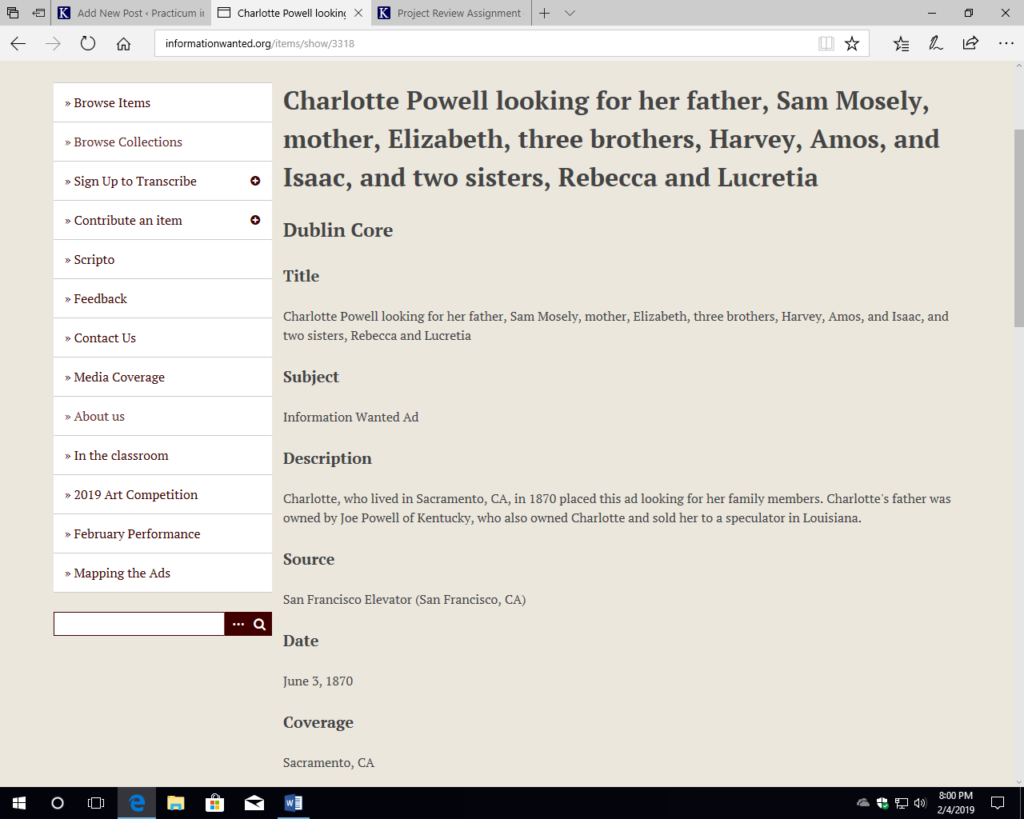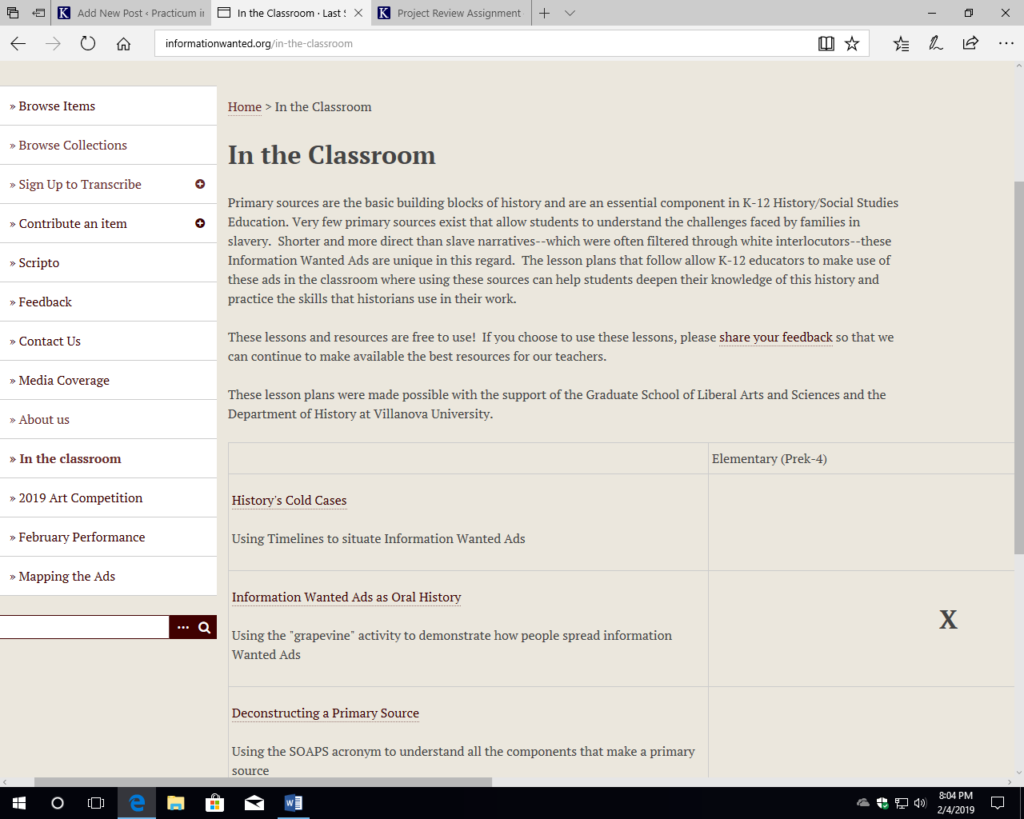Last Seen: Finding Family After Slavery; a Review
Last Seen: Finding Family After Slavery. http://informationwanted.org/. Created and maintained by the Department of History at Villanova University in collaboration with Mother Bethel AME Church, http://informationwanted.org/about-us. Reviewed January 27, 2019-February 4, 2019.
Worked by a team of graduate students within Villanova’s history department, Last Seen: Finding Family After Slavery serves as a digital archive and teaching website that collects, transcribes and stores newspaper ads taken out by former slaves searching for their family members. The purpose of the website, as argued by the Last Seen team, is to provide new primary sources to genealogists and researchers, engage with the public, teachers and grade school students over the history of slavery, and give agency to former slaves that lived throughout colonial and United States history. Through the gathering of these newspaper sources and the methods employed by the Last Seen team in running the project, there are a series of different ways in which the have gone about achieving these goals.

First, by focusing solely on archiving the ads posted in black newspapers, the Last Seen team does aid in giving historical agency to former slaves. Many other primary source documents that have been employed by researchers in the past who have studied slavery were written by non-slaves and even slave owners. Examples of such documents include slave ship manifests, bills of sale, plantation records, and personal letters and diaries of slave owners and abolitionists. There are slave narratives and primary source documents written by literate free and enslaved blacks from the period, but it is difficult to take such a small number of sources and employ them as the voice of millions. These ads do function as another outlet in which the voice of former slaves, including many individuals that were illiterate, can be heard. They also showcase the dismembering of families throughout slavery’s existence and the perseverance and drive of those free from bondage to find their loved ones.
In archiving unique sources that provide agency to former slaves, the Last Seen team is creating a new resource tool for historians and researchers. Employing the use of this archive, academics can further instill the voice of former slaves into their own work. This archive is also very beneficial to genealogists attempting to trace family lineages in which the ancestors of an individual were slaves. As indicated on the front page of their website, many of these ads include the name and location of the individual who took out the ad, and the names and last known location of the people they were searching for. These locations could be a great distance from one another and hard for a modern day researcher to discover. A quick search by a genealogist in the Last Seen archive helps link geographically distant parties together.

There are several tactics employed by the Last Seen team which allows for interaction with the general public and grade school students. The first of these is that the digital archive is both free to use and is not closed off for academic use only. Anyone can search and browse the archives, granting everyone the ability to gain incite on the lives of former slaves and the impact that the institution of slavery had throughout history. The Last Seen team also enables the public to interact with the project by having a contact page, hosting public readings of the sources, allowing others to upload primary source ads to the archive, and by utilizing volunteers to transcribe ads discovered by the Villanova grad students and others.

The team has also created a section of their website specifically as a location for uploading lesson plans that can be used by teachers instructing anywhere from pre-K to twelfth grade. These lessons do a great job in showcasing the importance of primary sources, the training and skills of modern historians, and the specific importance of these ads as primary sources used in understanding the institution of slavery and providing agency to former slaves.

Along with the accomplishments listed above, as a digital archive and website Last Seen permits much faster access to these advertisements than if they were published in a printed source. Furthermore, it is much easier to add to the database as an online entity, rather than having to constantly print updates to a written catalogue. Lastly, with making the project’s resources easily accessible as an online site, it allows the team to better engage in public and student outreach.
There are a few drawbacks to the archive and website design, though. First, the ‘About Page’ does highlight who the individuals are that work on the project, but it gives no information on the project’s ultimate goals, objectives and arguments. Visitors to the website will only discover these by searching extensively from one page of the site to the next. It is okay to reiterate certain objectives in different locations, but there should be a area on the website where all objectives, goals and arguments are together and defined more concretely. Additionally, it is not clearly defined how the team is going about the process of obtaining the primary sources. The ‘About Page’ simply states that the graduate students are ‘scouring microfilm.’ The team does not indicate how they validate public submissions as being accurate primary sources as well.
Secondly, the archive can only be searched by an ad’s upload date or alphabetically. The Last Seen team has created an interactive map that permits individuals to search records geographically, but this option should be made available within the listed archive. Documents should also be able to be searched chronologically.
With the exception of these critiques, Last Seen does overall accomplish the team’s goals. With only a small staff, Last Seen: Finding Family After Slavery is a well handled and important project.